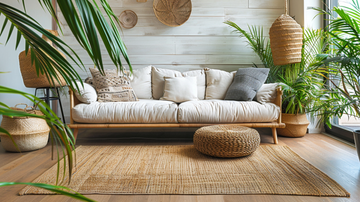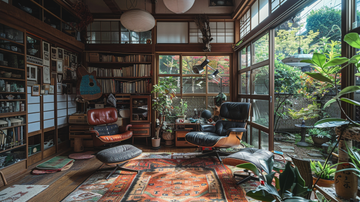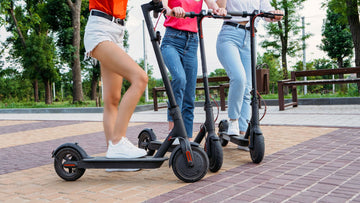What is Environmental-friendly Furniture?
Environmental-friendly furniture, also known as eco-friendly or green furniture, refers to furniture products that are designed and manufactured with minimal negative impact on the environment. These pieces are typically made from sustainable, renewable, or recycled materials and are produced through processes that reduce energy consumption, waste generation, and harmful emissions.
Common materials used in eco-friendly furniture include bamboo, reclaimed or recycled wood, natural fibers like jute and seagrass, and plant-based or recycled plastics. The production process often involves water-based, low-VOC (volatile organic compound) finishes and adhesives, as well as efficient manufacturing techniques that minimize waste. Compared to traditional furniture, eco-friendly alternatives offer several benefits, such as reduced carbon footprint, conservation of natural resources, and improved indoor air quality due to the absence of harmful chemicals (Source).
Early Pioneers and Motivations
The origins of environmental-friendly furniture can be traced back to the 19th century in Britain, where rural craftspeople began making simple, economical chairs from locally sourced wood species. These "sustainability pioneers," as described by furniturelink, were motivated by resource scarcity and a desire to minimize waste.
During the Progressive Era in the early 20th century, Louise Brigham, an American furniture designer, social activist, and teacher, emerged as a significant figure in the early history of sustainable furniture design. As detailed in the book "Louise Brigham and the Early History of Sustainable Furniture Design", Brigham was driven by concerns over the environmental impact of industrialization and a commitment to promoting social and economic equity through her designs.
Emergence in the Late 20th Century
The late 20th century witnessed a significant surge in the development of environmental-friendly furniture, driven by the growing environmental consciousness and the rise of green movements. As consumers became more aware of the impact of their choices on the planet, the demand for sustainable and eco-friendly products, including furniture, steadily increased.
One of the key catalysts for this shift was the emergence of pioneering companies that prioritized sustainability in their manufacturing processes and product designs. These companies recognized the importance of reducing their environmental footprint and began exploring innovative materials and techniques to create furniture that was not only aesthetically pleasing but also environmentally responsible. Notable examples include companies mentioned in this source.
The 1980s marked a pivotal moment for the furniture industry, particularly in North Carolina, which was then considered the "golden era" of the state's furniture production. According to this source, employment in the industry peaked at 90,000 people, and nearly 200 new furniture companies emerged during this period. While not all of these companies focused on environmental-friendly furniture initially, the growing consumer demand for sustainable products prompted many to adapt and incorporate eco-friendly practices into their operations.
Materials and Manufacturing Processes
The core of environmental-friendly furniture lies in the sustainable materials and energy-efficient production methods used. Some of the most eco-friendly materials include:
- Bamboo: A rapidly renewable grass that is highly durable and versatile, bamboo is a popular choice for furniture due to its sustainability and strength. It requires minimal resources to cultivate and can be harvested without damaging the plant's root system.
- Reclaimed Wood: Repurposing wood from old buildings, shipping pallets, or other sources reduces waste and preserves resources. Reclaimed wood often has a unique character and patina that adds character to furniture pieces. Source
- Natural Fabrics: Materials like organic cotton, linen, and wool are biodegradable and typically produced with fewer chemicals and pesticides than synthetic fabrics.
Beyond materials, eco-friendly furniture manufacturers prioritize energy-efficient production processes and life cycle analysis. This includes minimizing waste, using renewable energy sources, and designing products with end-of-life recycling or biodegradability in mind.
Design Innovations and Trends
The eco-friendly furniture industry has witnessed a surge of innovative designs that marry sustainability with style and functionality. Contemporary designers are pushing the boundaries, creating pieces that not only reduce environmental impact but also captivate with their aesthetic appeal. Notable pioneers in this field include Eva Furniture, known for their cutting-edge use of recycled materials and 3D printing techniques.
One prominent trend is the incorporation of reclaimed and repurposed materials, transforming what was once discarded into stunning furniture pieces. From wooden pallets reimagined as rustic coffee tables to discarded plastics woven into sleek chairs, these designs not only divert waste from landfills but also add character and uniqueness to living spaces.
Additionally, advancements in technology have opened up new avenues for sustainable design. AI-driven design algorithms are being employed to optimize material usage and minimize waste, while 3D printing allows for the creation of intricate and customizable pieces using eco-friendly filaments derived from plant-based or recycled sources.
Certifications and Regulations
As the demand for environmental-friendly furniture grew, various third-party certifications and eco-labels emerged to ensure product sustainability and transparency. The SCS Indoor Advantage certifies furniture based on low VOC emissions and indoor air quality. The BIFMA e3 Furniture Sustainability Standard evaluates products across multiple criteria, including material use, energy consumption, and end-of-life management.
Governments have also implemented policies and regulations to promote sustainable furniture manufacturing. The European Union's Furniture Products Regulation, for instance, restricts the use of certain hazardous substances in furniture production. In the United States, the EPA's Comprehensive Procurement Guidelines encourage the use of recycled and bio-based materials in furniture purchased by federal agencies.
The Future of Eco-Friendly Furniture
The eco-friendly furniture industry is poised for continued growth as consumers become increasingly conscious of their environmental impact. Emerging technologies like 3D printing and robotics are enabling more efficient and sustainable manufacturing processes, reducing waste and energy consumption. The concept of a circular economy, where products are designed for disassembly and reuse, is gaining traction, promoting closed-loop systems and minimizing the need for virgin materials.
However, challenges remain, such as the higher costs associated with sustainable materials and production methods, as well as the need for greater consumer awareness and demand. Opportunities lie in innovative material sourcing, such as using agricultural waste or recycled plastics, and in developing new business models that prioritize product longevity and end-of-life management. According to Exploding Topics, sustainability trends like green hydrogen, nuclear power, and electric vehicles are expected to drive the demand for eco-friendly furniture in the coming years.








